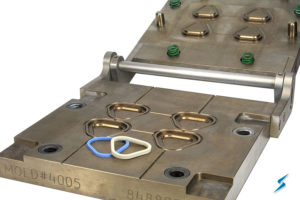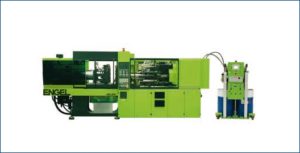When determining your silicone rubber provider, it is important to consider what method of molding you would like your silicone product to have. There are a few different method of molding silicone rubber components, each having their own advantages, and disadvantages.
These methods are:
- Extruding Molding
- Transfer Molding
- Compression Molding
- Liquid Injection Molding
Extrusion molding is a unique process for making silicone tubing or reel dispensing products. The molding machine has a continuous feed of silicone force fed through a die that generates the shape of the end product. Some examples of silicone products that use extrusion molding are: Medical tubing, cable wrap, and reel gaskets.
Transfer molding is used for specially formulated silicones. The silicone is placed in a chamber and heated to a liquid, then a plunger presses the material through a sprue to a runner system and into the mold cavities that are heated. The part is removed after curing. Transfer molding is more widely used in overmolding silicone products. Some examples might be kitchenware, and handles of medical devices.
Compression molding is one of the more commonly used methods of molding silicone rubber products, especially overseas. Compression molding is also one of the more simple methods of molding silicone rubber products, however it utilizes an open-air and labor intensive process.
The silicone rubber used in compression molding is pre-catalyzed by adding powder to the silicone. This enables the silicone to cure once introduced to heat. To add pigment to the silicone, the silicone must be mixed using a two-mill roll. This is a labor intensive process that has the possibility for contamination of the silicone. Once the material is pre-catalyzed and pigment is added it is weighed and often reshaped to the approximate size and configuration of the desired part. The material is then directly placed into the mold cavity. The machine then closes and compresses the material between the two mold halves. Compression molding machines utilize heated molds to melt the silicone and vulcanize.
The last method is liquid injection molding of silicone rubber, or LIM for short. This method utilizes liquid silicone rubber instead of a high consistency rubber or gum stock. The high viscosity liquid silicone rubber used in LIM is made of two parts. An A and a B. Both parts are a liquid, but only one part contains the catalyst which is typically platinum. This method of molding provides a “closed-loop system” which basically means that the raw silicone is sealed from the moment it is placed on the machine, until the moment a silicone rubber product is made. This helps keep contaminations to a minimum. Lowering the amount of handling of the silicone rubber also decreases the chance of contamination of the silicone components. If quality of the silicone rubber product is what your company is looking for then LIM is the best solution for you.
At SiTECH, we only use liquid silicone for all of our products, allowing us to be more dependable in duplicating our processes. We have made silicone products for many industries, and we would love to help you with your next product, contact us today!










